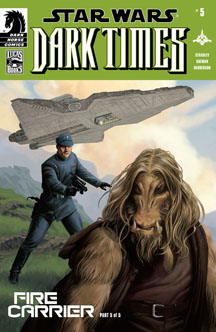“Dark Times” checks back in with Master K’Kruhk for “Fire Carrier,” Issues 23-27 (2013), which – despite not being drawn by Douglas Wheatley (Gabriel Guzman’s crisp art isn’t a bad substitute, though) – is my favorite arc from the series, and one of the elite arcs among all “Star Wars” comics.
By this point, “Dark Times” had established itself as having a big heart due to the makeshift family formed by two groups — the Uhumele crew (whom we’ll revisit shortly) and the younglings under K’Kruhk’s charge – but also a dark underbelly, as we see some of the galaxy’s grimmest depredations. A high bar (or low bar, as it were) was set back in the opening arc, “The Path to Nowhere,” when Bomo’s daughter is purchased, killed and eaten by a slaver cannibal. “Fire Carrier” arguably does that one better as the Arkinnea militia, in a parallel to Nazi Germany, hauls refugees to the promise of settlements in the north via an ore hauler. It empties the bottom hatches, dropping refugees to their deaths on the rocks below.
Against this harrowing backdrop, writer Randy Stradley explores noble Imperial officers. Commander Teron and Captain Denimoor served under K’Kruhk at the Battle of Saleucami (although they aren’t referenced in those issues of “Republic”). They arrest the mass-murdering militia members, and Teron helps fund and supply K’Kruhk’s makeshift Jedi academy in the backwoods of Arkinnea. Teron tells K’Kruhk:
“Those who do (speak positively about the Jedi) are immediately arrested and never heard from again. But some of us remember the good the Jedi did.”
After a few years of Teron supplying seeds every spring as promised, K’Kruhk’s group doesn’t hear from him again, and he never appears in another “Star Wars” story. It makes for a poignant epilogue.
While not as masterful as “Fire Carrier,” “A Spark Remains,” Issues 28-32 (2013), is a nice denouement to the series, even though it wasn’t intended to be the finale (Dark Horse’s loss of the “Star Wars” license in the Disney purchase meant “Dark Times” was canceled). Stradley and Wheatley return the lens to Dass Jennir and the Uhumele crew, who intend to make a play to assassinate Darth Vader. They know they’ll die in the attempt, but the fatalistic undertone gives way to hope in the final pages, as most of the crew survives to fight another day (needless to say, so does Vader).
I like how Stradley brings back Jedi Master Kai Hudorra, who dumped his lightsaber in a Coruscant garbage chute and opted to carve out a life as a gambler back in “Republic” Issues 79-80. Finally realizing that it was Jennir who made the correct decision to keep on fighting the Empire, Hudorra sacrifices himself to save our “Dark Times” heroes in the showdown on Kestavel. We never find out what happened to Hudorra’s Padawan, Noirah Na, though. Again, while some lingering fates provide a certain poetry to the aftermath of Order 66, it’s even better when story points link together.

Speaking of which, the Emperor had told Vader in previous arcs that he had a plan to deal with renegade Jedi. In “A Spark Remains,” we find out that plan consists of one dark Jedi, the Verpine Beyghor Sahdett, who had been traveling with the Uhumele. So “Dark Times” misses an opportunity to explore Palpatine’s training of the various Imperial dark-side adepts and inquisitors here.
The most lingering holes in the Legends continuity left by “Dark Times’ ” cancellation, though, are the fates of the various Jedi. From the K’Kruhk storyline, there’s darkness-touched youngling Sidirri and Master Zao, who goes after her when she runs off. Stradley said in an interview that he always intended Sidirri to go on to become the unnamed female Force-user who seeks to become Vader’s apprentice in the “Empire” arc “Betrayal.” While that’s cool behind-the-scenes information, it would’ve been better to see a transitional story in comic form, perhaps with Sidirri killing Zao.
K’Kruhk, for his part, pops up again in “Legacy,” as Whiphids are a long-lived species. And it’s implied that he hooks up with the Skywalker/Solo clan at some point, as he delivers R2-D2 into the care of Cade Skywalker. But it’s weird that the budding Jedi on Arkinnea are never heard from again. K’Kruhk doesn’t even explain what happened to them when he returns in “Legacy.” It would’ve been perfect if they – and perhaps Dass Jennir — had emerged around the time of the “Jedi Academy Trilogy,” when it was safe for Jedi to come out of hiding. But of course, those books had already been written and populated with their own Jedi.
Someone reading the “Star Wars” Expanded Universe materials in chronological order would find it unsatisfying that Jennir, the Uhumele crew and K’Kruhk’s young Jedi – all of whom are invested in striking blows against the Empire, not merely surviving — disappear from the overall narrative without explanation.
On the other hand, “Dark Times” goes down as masterful series with Stradley doing his most polished writing and Wheatley doing art-gallery level work. If a fans’ goal is simply to consume the best “Star Wars” stories, “Dark Times” should be on the short list.

